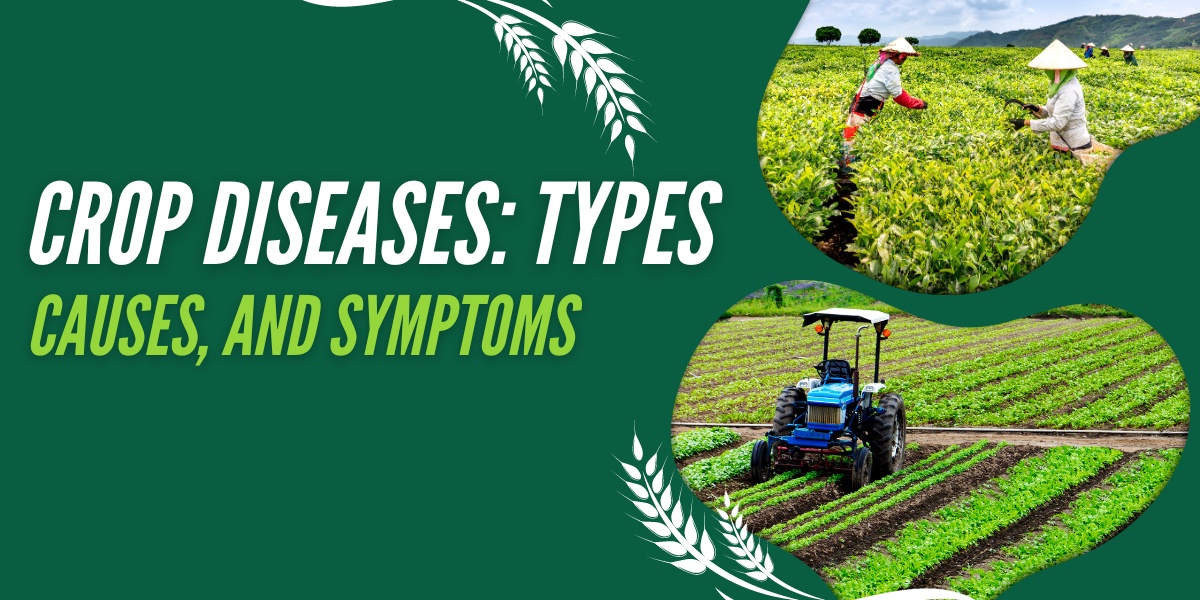Crop diseases are a formidable challenge to global agricultural productivity, with the potential to devastate entire harvests, resulting in economic losses and food shortages. For farmers to effectively combat these threats, it is imperative to grasp the diverse types, causes, and symptoms of crop diseases.
1. Types of Crop Diseases:
A). Fungal Diseases:
-
Fungal diseases are among the most common and destructive crop ailments. They are caused by various types of fungi that infect plants, leading to wilting, rotting, and reduced yields. Examples include powdery mildew, rust, and fusarium wilt.
B). Bacterial Diseases:
-
Bacterial diseases affect crops by invading plant tissues and disrupting their normal functions. Symptoms may include leaf spots, wilting, and tissue necrosis. Common bacterial diseases include bacterial blight, fire blight, and crown gall.
C). Viral Diseases:
-
Viral diseases are caused by plant viruses transmitted through vectors such as insects, nematodes, and fungi. These diseases can cause stunted growth, leaf mottling, and yellowing. Notable examples include mosaic viruses, leaf curl viruses, and tobacco mosaic virus.
D). Parasitic Diseases:
-
Parasitic diseases are caused by parasitic organisms such as nematodes, mites, and aphids. These organisms feed on plant tissues, causing damage and reducing yields. Root-knot nematodes, spider mites, and aphids are common parasites affecting crops.
E). Nutritional Disorders:
-
Nutritional disorders result from imbalances or deficiencies in essential nutrients required for plant growth. Symptoms include chlorosis, stunted growth, and abnormal development. Examples include nitrogen deficiency, potassium deficiency, and iron chlorosis.
2. Causes of Crop Diseases:
A). Environmental Factors:
-
Environmental factors such as temperature, humidity, and rainfall can create favorable conditions for disease development. Warm and moist environments are often conducive to fungal and bacterial diseases, while drought stress can weaken plants, making them more susceptible to infections.
B). Pathogen Presence:
-
Pathogens such as fungi, bacteria, viruses, and parasites are the primary causes of crop diseases. These pathogens can spread through contaminated soil, water, seeds, plant debris, and insect vectors, infecting healthy plants and spreading rapidly within fields.
C). Poor Cultural Practices:
-
Improper agricultural practices such as monoculture, inadequate crop rotation, and improper irrigation can contribute to the proliferation of crop diseases. Monoculture promotes the buildup of pathogens specific to certain crops, while poor irrigation practices can create waterlogged conditions ideal for fungal growth.
D). Genetic Susceptibility:
3. Symptoms of Crop Diseases:
A). Leaf Lesions:
-
Leaf lesions appear as spots, blotches, or necrotic areas on plant leaves. These lesions may vary in size, shape, and color depending on the type of pathogen causing the disease. Fungal and bacterial infections commonly result in leaf lesions.
B). Stunted Growth:
-
Stunted growth is a common symptom of crop diseases, particularly those caused by parasitic organisms and nutritional deficiencies. Infected plants may exhibit reduced vigor, smaller leaves, and overall poor growth compared to healthy plants.
C). Wilting:
D). Leaf Deformation:
-
Leaf deformation refers to abnormal growth patterns or structural abnormalities in plant leaves. Viral diseases are known to cause leaf deformation, resulting in curling, distortion, or cupping of leaves.
E). Discoloration:
-
Discoloration of plant tissues, such as yellowing, browning, or chlorosis, is a common symptom of crop diseases. Nutritional deficiencies, viral infections, and physiological disorders can all lead to discoloration, indicating underlying health problems in plants.
4. Prevention and Management Strategies:
Crop Rotation:
A). Resistant Varieties:
B). Sanitation:
-
Practicing good sanitation measures such as removing crop residues, weeds, and diseased plants can help eliminate potential sources of inoculum and reduce disease spread within fields. Proper cleaning and sterilization of equipment and tools can also prevent cross-contamination.
C). Biological Control:
-
Biological control methods involve using natural enemies such as beneficial microorganisms, predators, and parasites to suppress pathogen populations and manage crop diseases. Biological control agents can be applied as biopesticides or incorporated into soil as soil amendments.
D). Integrated Pest Management (IPM):
-
Integrated pest management integrates multiple pest control strategies, including cultural, biological, and chemical methods, to minimize the use of synthetic pesticides and mitigate the risk of pesticide resistance. IPM emphasizes monitoring, decision-making, and sustainable practices to maintain crop health and productivity.
Conclusion:
Crop diseases represent a significant challenge to global food security, but with proper understanding and management, farmers can effectively mitigate their impact and safeguard crop yields. By recognizing the types, causes, and symptoms of crop diseases, implementing preventive measures, and adopting integrated pest management strategies, farmers can protect their crops and ensure sustainable agricultural production for future generations. Continued research, innovation, and collaboration are essential to develop resilient crop varieties and sustainable farming practices that can withstand the threats posed by crop diseases in a changing climate.


No comments yet